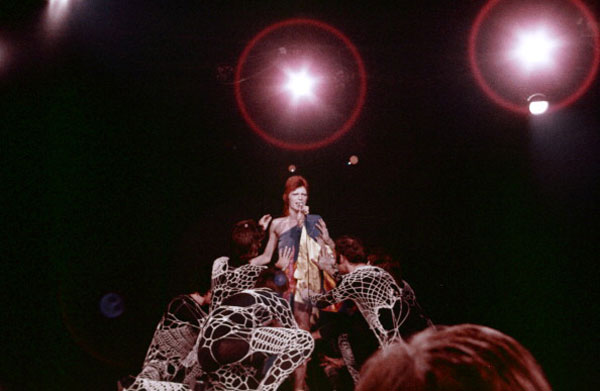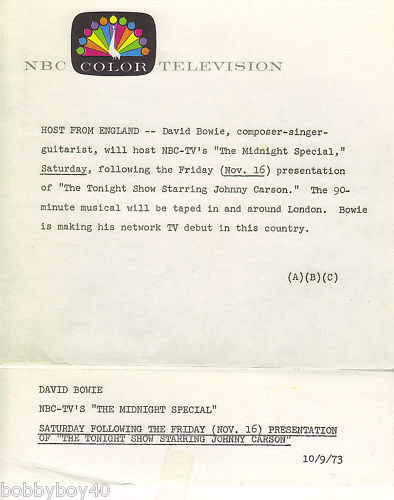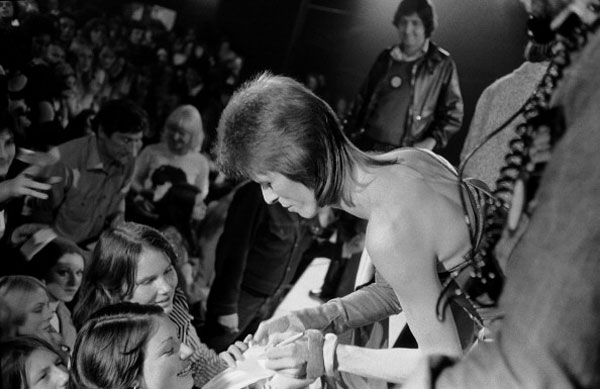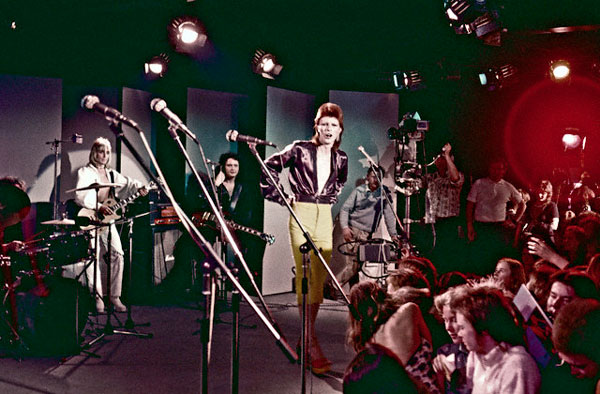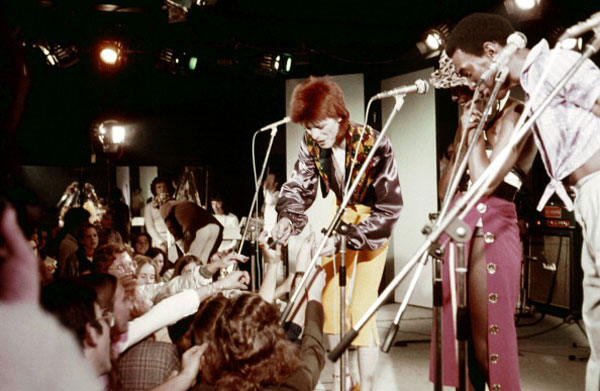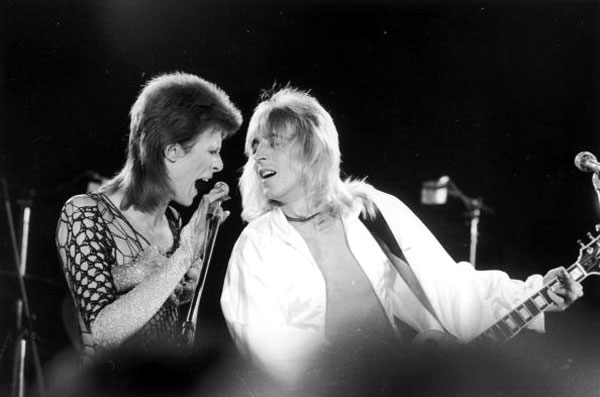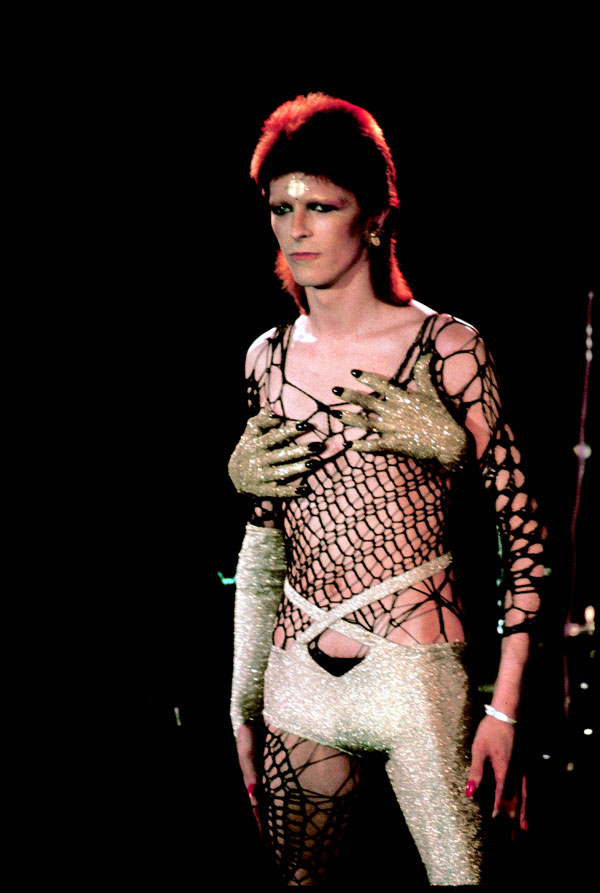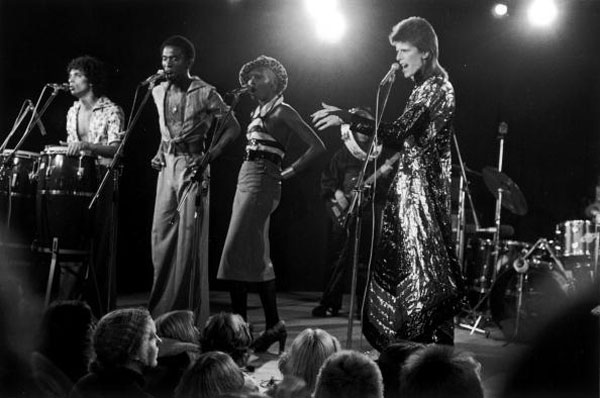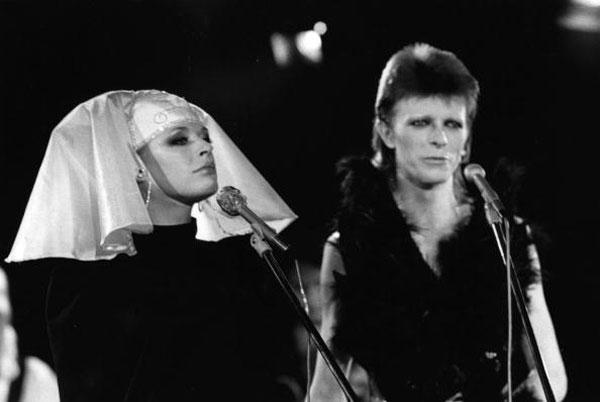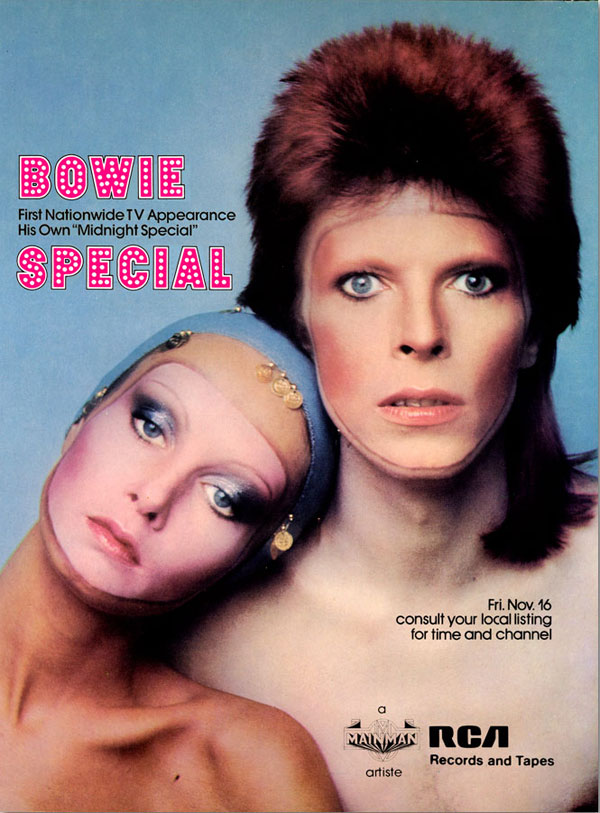1970 • 1971 • 1972 • 1973 • 1974
1975 • 1976 • 1977 • 1978 • 1979 • 1980
THE MAN WHO SOLD THE WORLD • HUNKY DORY
THE RISE AND FALL OF ZIGGY STARDUST
AND THE SPIDERS FROM MARS
ALADDIN SANE • PINUPS • DIAMOND DOGS
YOUNG AMERICANS • STATION TO STATION
LOW • HEROES • LODGER • SCARY MONSTERS
ZIGGY STARDUST THE MOTION PICTURE
THE 1980 FLOOR SHOW • CRACKED ACTOR
THE MAN WHO FELL TO EARTH • THE ELEPHANT MAN
FEATURES • PRESS ARCHIVE
BOWIEGOLDENYEARS is currently being expanded and redesigned
gold page links are live
|
The 1980 Floor Show
Recorded Thursday October 18 to Saturday October 20 The Marquee Club, 90 Wardour Street, Soho, London Produced and directed by Stan Harris David Bowie: Concept and Design Dooshenka (Amanda Lear): Compere David Bowie (vocals, guitar, tambourine, harmonica) The Astronettes Tuesday October 9
NBC-TV announces the forthcoming Midnight Special featuring Bowie. Barely cold in the grave, Ziggy was exhumed for one last performance for American television. Tony DeFries devised it to get Bowie the exposure in the US that was lost when RCA cancelled the arena tour. This way RCA would pay for an advertising campaign to support both the album and the television special titled The 1980 Floor Show. Wednesday October 17 The 1980 Floor Show rehearsals Bowie's idea to tape it at the Hammersmith Odeon was rejected as too expensive so he opted for the Marquee Club. It was appropriate since Pinups paid tribute to the bands Bowie had watched there and he had also played there with The Buzz and The Lower Third.
The show was also a preview of his new funkier direction – a new song 1984/Dodo and Ava Cherry's debut as part of a trio with Jason Guess (discovered in a soul food restaurant) and Geoff MacCormack, who adopted a joke stage name, Warren Peace. Named the Astronettes (after the dance troupe from the August 1972 Rainbow shows), DeFries added them to the MainMan roster and Bowie would produce their album in November. Marianne Faithfull agreed to perform on the show and introduced Bowie to Amanda Lear, an exotic model of indeterminate age and gender who compered the show as the faux Russian, Dooshenka. They had almost met in August 1972 when she introduced Roxy Music onstage when they supported Bowie at the Rainbow. She had been Bryan Ferry’s fiancée and featured on the cover of Roxy Music’s For Your Pleasure. Thursday October 18 Choreography
On the first day the club was a closed set as they filmed choreography for the opening titles, with dancers arranging themselves to spell out the letters – an idea inspired by the drawings of Erté – on a checkerboard painted stage. Behind them, white panels swung into view on pivots to form black and white stripes – evoking the old Marquee backdrop. The dancers wore the crocheted elastic spider web costumes that Natasha Korniloff designed for the original Astronettes in the August 1972 Rainbow concerts. Bowie emerged wearing a new Freddie Burretti suit, and serenaded Amanda Lear/Dooshenka with Sorrow, singing live to a backing track, followed by a surrealistic conversation based on the Caterpillar episode in Alice in Wonderland.
Friday October 19 As Tears Go By (with Marianne Faithfull) For the second and third days of shooting, groups of 200 drawn from the Bowie fan club were brought in to inject some live energy into the show. However, with the club too small for multi-camera shooting, the audience endured five to six retakes and interrupted performances as two cameras were re-positioned between takes to cover the different angles. Marianne Faithfull reprised her 1968 Rock ‘N’ Roll Circus performance of As Tears Go By.
Five or six takes were shot of Time to include Bowie interacting with the front row of the audience. Saturday October 20 Session 1 Bulerias (Carmen) The third day of shooting was devoted to the majority of the live performances. The music press was invited to report on the show that UK fans were unlikely to see. Showtime was advertised as 11.30, but the shoot was already behind schedule as Carmen filmed takes of their song Bulerias, delayed when the wrong backing track was played over the PA. Carmen was a Latin flamenco rock band from Los Angeles, added as a favour to Tony Visconti, who had recently produced their album Fandangos In Space.
As Bowie dressed in the adjoining backroom where Ken Scott and Robin Mayhew had set up the soundboard, Ronson directed the band through a couple of instrumental run-throughs of Everything's Alright.
Bowie finally appeared at 3.15pm and launched into the song, only to be signalled to an abrupt halt when one of the lights went off. The next take got as far as the opening riff. By the fourth take Bowie and the technicians were satisfied and they reshot it from the audience and sidestage, playing to the audio of the fourth take.
The kids at the front besieged him and the band for autographs – as they did in every break in the filming. There was a flurry of interest with the arrival of MainMan artiste Wayne County. Mild hysteria greeted Angie’s arrival with Zowie. Space Oddity followed, with Ronson and Dunbar playing harder and heavier than usual. Ronson broke a string playing his guitar solo, but the take was deemed good enough and they reshot from the other angle. Bowie vanished again to change, re-emerging in thigh length black PVC boots, a scarlet PVC corset, a big feather starting at his navel and extending up past his ears and matching feather wristlets.
Wth make-up artist Barbara Daly backstage He announced the next number as The Laughing Gnome (the reissued 1967 Deram single had reached number 6 the previous week) before launching into I Can’t Explain. Session 2 The Jean Genie The 200 fans were ushered out to make way for the next 200. The Jean Genie
Ronson broke another guitar string during the solo in The Jean Genie. He persevered before deciding the solo would suffer unless the string was replaced.
Bowie performed in a netted costume with a pair of glittery hands reaching across his chest. The hand over his crotch had been deemed too risqué for American television and was removed. After a playback of the first take showed his jockstrap was visible Bowie went backstage to remove that as well. For the second take, they mimed to the previous take with Bowie revealing more now his underwear was gone. Then Bowie reached for his harmonica to mime to his already-recorded solo, realised it was missing from its place on top of Trevor Bolder's amp, shrugged and mimed the part without it. Despite this the television crew was happy with the take, confident that "it won't show". On the broadcast, however, Bowie appeared clearly perplexed. 1984
Following another costume change, Bowie announced the next song. "We've written a musical, and this is the title song called 1984. We'll be doing the show in March next year." After a number of false starts and yet another broken guitar string, they managed a complete take after which, Bowie gave Ronson a pat on the back. After a fourth take (miming to playback for the other angles) Bowie vanished backstage, reappearing in his Angel Of Death red PVC and black feathers outfit.
Backstage with Suzi Fussey and Angela Bowie I Got You Babe
"Marianne Faithfull on stage now, please," came the announcement and she appeared in a backless nun’s cowl to join him Bowie for the Sonny and Cher duet, I Got You Babe. As she reached to adjust the microphone between takes, the cowl gaped open, revealing she wore nothing underneath the body stocking. As roadies packed up Bowie’s gear, most of the audience left and The Troggs recorded their three numbers. According to Charles Shaar Murray, Ronson – in the middle of mixing his album – hated every minute of the television taping.
Friday November 16
The 1980 Floor Show broadcast Despite NME's later report that ITV had secured the British screening rights, it was never broadcast in the UK. |
Bowie Golden Years v1.0 created and designed by Roger Griffin 2000
Bowie Golden Years v2.0 2017-2020
Photographs and texts have been credited wherever possible
this page updated February 19, 2022
